FPA presents 2010 Flexible Packaging Achievement Awards
March 11, 2015
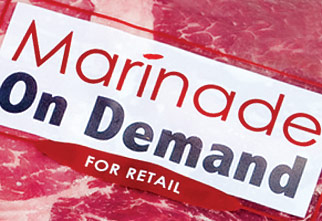
Be they standup pouches with perforations and reclosable zippers, stiff-yet-elastic wraps, bags and pouches that double as handy serving bowls or storage devices, the winners of the Flexible Packaging Association's 2010 Flexible Packaging Achievement Awards offer added value. This year's award winners also feature compartmented structures that combine two or more products in one package and glowing printing techniques that offer color shifts or different depths of color, Special constructions appeared on the scene this year, designed to enhance stability or display properties, or, outfitted with special layers, withstand the stresses of retorting. Other noteworthy winners include environmental structures that replace volatile packaging components with more sustainable elements.
The winners were chosen from 85 submitted entries in 117 categories. Of those, 22 packages were honored with 23 achievement awards, all announced on March 10 during the FPA's annual meeting in Orlando, FL.
The winners receive gold and/or silver awards in Packaging Excellence, Printing Achievement, Technical Innovation and Environmental & Sustainability Achievement categories. Winners also can earn the Highest Achievement award, which along with the gold winners, are presented here. Descriptions for all winning entries, including the silver awards listed at the end of this article, can be found on our website at www.packagingdigest.com.
Meritorious marinade pack
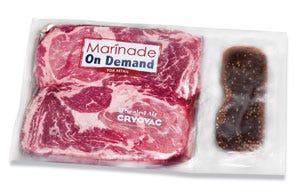
Value-added flexibles
This year, the Highest Achievement winner is Sealed Air Corp.'s Cryovac Food Packaging Div. for the Marinade On-Demand™ package (1). Also taking a gold award in Technical Innovation, the compartmented package transforms fresh meat or poultry from plain to deliciously flavored in minutes. Developed in 2008 and introduced commercially by Schwan's in 2009, the clear package consists of a two-part, thermoformed film rollstock that separates the meat contents in one compartment from a restaurant-quality marinade in the other.To begin the marinade process, the user squeezes the marinade pocket to break a seal, which releases the marinade into the meat compartment. This action starts the marinating process that can last as long as the user desires. Convenient, sanitary and controlled, this process preserves meat quality and meets demand for high-performance packaging materials, says Cryovac's Walker Stockley, marketing director for fresh red meat.
Used by Schwan's Home Service, Inc., a Marshall, MN home-delivery distributor of frozen products, and copacked by Chicago Meat Authority (www.chicagomeat.com), the new meat/marinade combination package prevents marinade ingredients such as acids, alcohols and fruit juices from “cooking” the meat or affecting its flavor or texture before the user is ready to do so. Functional, appealing and easy to use, the package provides food-safety benefits with hands-free marinating because it reduces direct contact with the raw meat. The frozen meat or poultry is marinated in a sealed environment. And foodservice and restaurant personnel no longer need to spend time cleaning large containers for batch-marinating purposes. which eliminates dirty pans.
Stockley reports that the quality of marinade used can be better controlled for a consistent product, time after time, cook after cook. And there's less waste because the correct amount of marinade is used every time.
The packaging is made using coextruded, high-barrier nonforming and thermoforming rollstock materials with easy-open properties, though Stockley says he cannot divulge the specific materials in the structure. The marinade on-demand package is leak-resistant, affords a knifeless opening and saves time and labor over packages containing premarinated meats, reducing the need to wash down equipment between batches. Processors can add the marinade at the packaging station. An in-line system allows continuous run of product with perhaps a 5- to 10-min changeover time between flavors, according to Stockley.
Machinable on existing thermoforming equipment, the two-part package has a peel-tab in one corner and a “frangible seal that expresses” the marinade into the adjacent meat pocket. While the frangible seal between cavities can be broken, the vaccum seal around the perimeter of the package is maintained.
Says Stockley: “The first-generation package was adequate for frozen product distribution, but a second-generation package has been designed for fresh-meat distribution [foodservice or retail], with the marinade contained in a separate, easy-open thermoformed portion-pack. The pack is inserted into a two-compartment thermoform package using non-easy-open films for security in distribution.”
Shelf life, he says, depends on the meat being packaged but is similar to conventional vacuum-packed fresh meats, which ranges from 21 to 28 days. “This typically is dictated by any additional processing steps prior to packaging,” he points out.
The package generally holds quantities dictated by how the package is formed, but it's not designed for a large roast, Stockley says. “Most products would be two inches in depth or less,” he tells PD. “The packages are designed to hold anywhere from a small grilling product to steaks and chops weighing two to two and a half lb. or less.”
Here are the gold award winners:
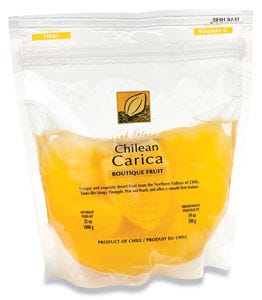
Value-added flexibles
Retortable, sustainable fruit pouch

Value-added flexibles
Ampac Flexibles won gold in Technical Innovation for a reclosable retort pouch (2) used by Tamaya Gourmet, a Santiago, Chile marketer of an unusual boutique fruit grown in Northern Chile called Chilean carica, also known as Chilean papaya. Distributed both online and through food distributors in the U.S. and Canada, the fruit enhances many dishes, from appetizers to salads and desserts, drinks and juice. The premade pouch, which is a bit more than 5 mils thick, withstands the rigorous high-temperature (185 to 250 deg F) retort process and stores unused portions of the fruit. With a proprietary, retortable zipper and built-in E-Z Tear linear-tear technology, the bag provides a clean, convenient opening at the top, eliminating ragged tears or the need for scissors. Product breakage is practically eliminated with the replacement of glass jars for the unusual fruit.
Produced and printed by Ampac's plant in Minneapolis on a Totani (www.totani.co.jp/en) bagmaking system equipped with an inline zipper applicator, the bagstock from the inside-out, comprises an adhesive lamination of 4 mils cast PP/59-ga oriented nylon/ink/47.2-ga high-barrier PET. The structure is specifically designed to resist the heat of retort applications, says Sal Pellingra, Ampac's innovation and marketing director. “The material withstands typical retort temperatures of 250 deg F, but this specific application is retorted at 221 deg F,” he says.
Pellingra indicates that Tamaya Gourmet pays $9.99 per pouch in the 1-kg size instead of $12.99 for a 1-kg glass jar.
Packed in Chile, the pouch also saves importantly in incoming freight charges, and saves on storage and distribution charges, Pellingra adds. Eight empty 16-oz jars can be stored or shipped in the same amount of space as 143 of the empty retortable 35-oz pouches—a 96-percent reduction in storage and shipping volume. And the pouch holds more than twice the amount of product, with 91 percent less material weight.
The stiff structure is durable, which makes it easier to pour the contents and juices out, and conveys high quality. The same high quality printing on the jar label is used on the transparent pouchstock. Ampac gravure-prints the stock using retort-grade inks on a Toshiba (www.toshiba-machine.co.jp) press in eight colors to maintain a sleek brand appearance.
The package represents a 23-percent savings in materials versus the glass jar, cap and label. Tamaya Gourmet reports other benefits in using the gusseted Doy Pack pouch structure: Less breakage and improved safety; the Doy Pack is well suited to supermarket produce sections; and with a reclosable zipper made of PP, is easily retortable. Completing the package is an easy-open tear nick, which adds to the pouch's consumer appeal.
With superior film clarity to highlight the look and color of the fruit inside, the filmstock accounts for less than 3 percent of the packaged product weight versus the jar, which accounted for 33 percent. Multiple pouch sizes and SKUs are in development, Pellingra says.
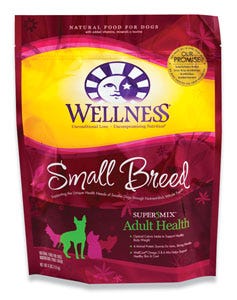
Value-added flexibles
Sit up and 'bag'

Value-added flexibles
For Printing Achievement, gold award winner Bemis Flexible Packaging, Milprint Div., earns kudos for the Wellness Small Breed dry dogfood bag (3). The 4-lb standup bag, adopted by Wellpet Foundation/Old Mother Hubbard, Tewksbury, MA, is gravure-printed using Bemis' proprietary KromaSilk™ technology, which provides a satiny look that results in eye-popping graphics and three-dimensional depth.
Wellpet wants its packaging to convey a top-quality image as does its product, which the company maintains is formulated with the best protein sources it can find. It introduced the products in this packaging in May 2008. The shiny/smooth PET/metallized PET/PE bagstock is gravure-printed in eight colors and is combined with the KromaSilk technology to enhance the bag graphics; the metalized bagstock adds shine and even more eye appeal. The KromaSilk printing technology involves a separation process that Milprint says delivers a variety of effects, from silky gradation transitions to pseudo holographic color shifts.
The deep colors schemes used on the Wellpet bags include one SKU featuring brightly colored graphic elements of animal silhouettes in pink, lime green and fuscia that are achieved using several different levels of color intensity. According to Milprint, the strength of the color depends on the angle in which it is viewed, much like the look of colors when tilted in a holographic image.
Milprint converts, prints and laminates the premade, side-gussetted bags in 15# and 30# calipers and also produces a 6# standup pouch with a bottom gusset. The silky, satiny look of the KromaSilk printing is softer than holographic images due to the separation of the base ink on a metal surface, says Kim Kolhbeck, marketing communications manager for Milprint. “KromaSilk provides a base for subsequent layers of ink that results in a multi-dimensional effect,” she says. “Covering the metal surface with various amounts of KromaSilk inks determines the effect.”
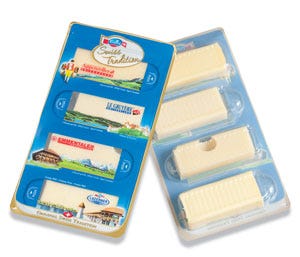
Value-added flexibles
Portion-pack offers a little or a lot

Value-added flexibles
Winning gold in Packaging Excellence, the Emmi Cheese Plate package (4) has an innovative, compartmented format and offers a refrigerated shelf life of 65 days. Produced by Amcor Flexibles using contour perforations, the package consists of an APET/PE base tray, thermoformed to a depth of 20 to 25 mm, depending on product weight.
The Amcor lid is a high-barrier polyester laminate with an innovative contour-micro-perforation, that's gravure-printed in nine colors. Amcor says the cheese is packaged with modified atmosphere. The package has four separate cavities sealed with the film lidding, which plays a critical graphic role in the launch of the cheese, which started in January 2010.
Emmi, one of Switzerland's leading cheese and dairy products companies, gives consumers a choice of opening the entire package at one time or accessing individual portions, thanks to the perforations in the packaging.
Claudia Poeckl, Amcor Flexibles' customer communications coordinator in Brussels, Belgium, says the proprietary perforation technology isn't new to Amcor, but is in constant development. Contrary to other perforation technologies, it can be customized to desired formats and designed into an infinite number of shapes. “The technology also offers convenience while maintaining perfect gas tightness in the pack,” Poeckl explains.
Holding four 40- to 50-g slices of cheese for a total of 160 to 200 g, the handy tray-pack includes hard cheeses available in the two varieties: Swiss tradition; and premium selection. Portioning the cheese helps keep unused product fresh and helps reduce waste. Consumers can select the different types of individually portioned cheese, by either completely peeling away the entire lid or by pushing one of the individual cavities open and removing a single piece, explains Birte Dorenkamp, team leader-packaging, at Emmi.
Emmi uses Multivac (www.multivac.com) horizontal thermoform/fill/seal equipment with a heat-sealing station to produce the packages.
Graphics clearly differentiate the cheeseboard on store shelves. The appealing blue or brown color scheme and images have been enhanced by matte and glossy printing effects, while film windows on the lid show off the tray's contents. Opening indicators are located in the corners of the package and on the individual cavities.
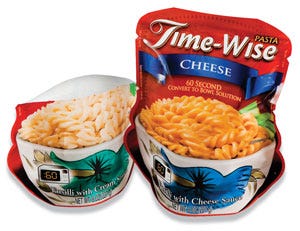
Value-added flexibles
Retort pouch as bowl

Value-added flexibles
A lightweight, retortable pouch that offers maximum flexible packaging convenience for a pasta product in a new format, the Time-Wise Bowl Pouch (5), made for Dainty Foods in Ontario, Canada by CLP Packaging Solutions Inc., is shelf-stable and ready for heat-and-eat diners on-the-go. Containing 8 oz of fusilli pasta with cream sauce, the package's heat-free handles make it comfortable to grip, even after 60 seconds in the microwave oven. Laser scoring along the centerline converts the pouch into a stable bowl. Another laser score on the top makes it easy to vent the pouch for microwaving and facilitates scissors-free opening.
The nonfoil, four-layer barrier laminate construction is microwaveable so that when the pasta is heated, the user simply tears a laser-scored strip along a beltline to fashion the pouch into serving ware. There's no need for extra serving dishes to use, clean or dispose of. The pouch won gold in Packaging Excellence.
CLP Industries reverse prints in gravure the pouch material (to resist scuffing) in eight bold colors on a Cerutti (www.cerutti.it) press. The package presents crisp, highly detailed graphics, photos and lettering. The rugged construction is designed for high performance retorting. The adhesive-laminated pouchstock comprises coated PETG/biaxially-oriented nylon/opaque white PP. The nylon layer adds puncture-resistance, elasticity and thermomechanical performance while the PETG layer affords a barrier.
The fact that the structure does not contain foil makes it microwaveable. The biaxially oriented nylon is a stiffening layer, which CLP says is important in maintaining the bowl's structural integrity during use. The PP sealing layer lends additional barrier properties and provides a bright white background for the graphics. The films are provided by Israel's Polyon Industries (www.polyon.co.il) and Polyplex Corp. Ltd. (www.polyplex.com), the adhesives are from Rohm & Haas (www.rohmhaas.com) and the retortable inks are supplied by Siegwerk Druckfarben AG (www.siegwerk.de).
The colors appear to glow in the light that passes through the laminate, which adds richness to the tasty-looking food photography. CLP uses retort-ready inks to maintain lushness from the retorting process through to handling and stocking of the product at retail stores and microwaving at home or in the office.
Produced in Israel by parent company, CLP Industries Ltd., on Totani pouchmaking machines that produce shaped pouches, the package and the product are both new to the market. The product is made and retorted in Mexico by CSM Alimentos S.A. de C.V. (+52 415 152 6970). Curvy in shape, which accentuates the graphics and artful printing and permit fast, efficient retorting, the adhesive-laminated standup pouch remains stable during heating while its value-added, heat-free lobe-like side handles prevent the discomfort that often accompanies grasping a hot pouch from the microwave oven.
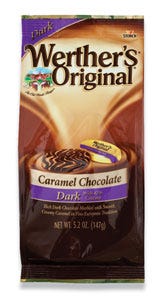
Value-added flexibles
Richly printed bag for chocolates

Value-added flexibles
Rich, luscious colors earned Werther's Original Caramel Chocolate Stabilo bag (6) high marks and a gold award in Printing Achievement for Sonoco Flexible Packaging. The milk and dark chocolate candies are produced by Germany's August Storck KG, based in Berlin. Representing an improvement over an existing package that included an additional display tray, the 5.2-oz standup bag incorporates a quad-sealed flat bottom that offers excellent shelf presence.
Providing superior stiffness and machinability on quad-seal vertical form/fill/seal equipment, the three-ply OPP/metallized OPP/OPP film structure has excellent hot-slip characteristics. It's also laminated using solventless adhesives.
Gravure printing of the enhanced graphics is in a luxurious purple (or red, depending on the flavor), cream and chocolate brown color scheme. The classic visuals depict chocolate and caramel cascading down on top of luscious gold foil-wrapped candy discs. Sonoco says the glossy, three-layer filmstock is made into bags on a Rovema (www.rovema.com) vf/f/s system.
Popcorn bag turns 'green'
A microweavable popcorn bag for American Pop Corn in Sioux City, IA (7), converted by Exopack LLC introduces Solvay's (www.solvay.com) Solexis fluoroelastomer and perfluoroelastomer grease-resistant coatings, which are designed to eliminate the introduction of perfluorooctanoic acid (PFOA) into the environment and eliminate the potential of being a by-product of the bagmaking or degradation process of the microwave popcorn bag.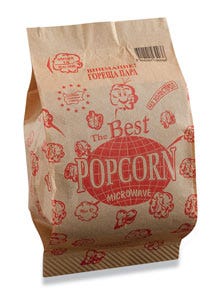
Value-added flexibles
PFOA is a synthetic, stable, perfluorinated carboxylic acid and fluorosurfactant that has applications as a surfactant in the emulsion polymerization of fluoropolymers. Produced since the 1940s in industrial synthesis, the synthetic chemical is of interest to the EPA and has been the subject of much debate regarding its potential health effects.
It's also formed by the degradation of precursors such as some fluorotelomers. PFOA is indefinitely persistent in the environment and has been known as a toxicant and carcinogen in animals. Some studies have associated PFOA exposure with birth defects, increased cancer rates and changes to lipid levels, the immune system and the liver—all effects identified in animals.
Exopack says the new coating replaces certain components within PFOA with shorter molecular chains, so the problems with PFOA and bio-accumulation are eliminated, yet the coating performs in a way that doesn't alter the consumer experience with the popcorn. The bag itself is made from two plies of grease-resistant paper laminated together and incorporating a metallized PET susceptor patch (to aid popping of the corn) sandwiched in between. The paper stock is flexo-printed in one color with American Pop Corn's trade dress and graphics.
Exopack says it worked closely with Wausau Paper (www.wausaupaper.com) on the bag's material formulation, to ensure that the paper bag's properties and treatment were adjusted to prevent popcorn grease from bleedthrough and staining the bag. “The best news is that the PFOA-free microwave popcorn bag was a drop-in for the predecessor,” says Chris Swalm, Expopack's corporate marketing manager. “The efficiency and economics were maintained.”
The resulting bag won a gold award for Environmental & Sustainability Achievement. Says Swalm, “One important component of packaging sustainability is to ensure that the package is safe for all possible end-of-life scenarios.”
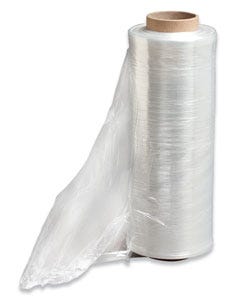
Value-added flexibles
Edgy stretch wrap

Value-added flexibles
Stratos™ handwrap (8), described by Pliant Corp., a subsidiary of Berry Plastics, as an ultra-performance stretch film with folded edges, also won gold in the Environmental & Sustainability Achievement category. Made with a proprietary blend of high-performance LLDPE and LDPE films, the formulation strikes a balance between stiffness for heavy-duty load containment, elasticity that allows users to pull the film tight around a load and superior puncture- and tear-resistance for corner handling. Yet it's only 35 ga thick.
Launched late in 2009, Stratos has a folded edge that helps eliminate product loss from “edge hang” while significantly improving load containment.
The addition of the folded edge also offers other major benefits: A roll of Stratos can be dropped on the ground and be reused without fears of product loss; and Stratos has substantial tear-resistance.
If the film is punctured on the pallet, the folded edge (which is folded in-line on Pliant's equipment and shipped to end user prefolded) will frequently stop a tear from propagating in the cross direction, and thus improve load integrity. Says Pliant's industrial films technical manager Mike Kinnan, the folded edge increases stiffness (due to strain hardening when stretched) of the film by 10 to 20 percent vs. the same formulation produced without a folded edge.
This can translate to 10 to 20 percent improved load containment just by the presence of a folded edge. The cast-coextruded wrap also has exceptional optics, Kinnan notes, and the cast process allows production of film that's susceptible to strain hardening, which is essential to load containment at thin gauges. Stratos isn't pre-stretched, so it can be pulled tight on a load, yielding another 10 to 25 percent extra yield, according to Kinnan.
The film has several sustainability savings advantages, Kinnan points out. Its thin gauge means that less film is used, which can reduce the carbon footprint. Its load-containment properties and bonuses associated with the folded edge can reduce the number of wraps needed to secure a load, thus further decreasing film usage and possibly transportation costs.
The folded edge also reduces waste associated with edge damage and edge hangover, which Kinnan says can be a frequent problem for stretch films at thin gauges.
“The amount of film applied and the wrapping technique used with handwrap is very specific to each user, but if the stiffness increases by 10 to 20 percent because of the folded edges, the end user likely could decrease the number of wraps by that same percentage and still get similar on-pallet performance,” Kinnan points out. The handwrap is available on rolls 1,500 and 2,000 ft in length; and in widths of 14, 16 and 18 in.
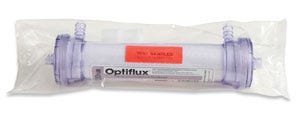
Value-added flexibles
Protective, attractive medical flowrap

Value-added flexibles
The Fresenius Dialyzer package forming web (9), again converted by Pliant Corp., won gold in Technical Innovation. A new solution for dialyzers, the innovative flowrap is cost-competitive and features a two-component, thermoformable nylon/PE-laminated bottom web, which is sealed to coated Tyvek®. The flowrap improves manufacturing efficiencies twofold, says Pliant. Through this package, Fresenius Medical, Ogden, UT, also improved sterilization techniques and converted from an EO gas to an E-Beam radiation technique. Fresenius produces the medical devices, which are distributed to hospitals and private nursing homes.
Dialyzers are synthetic membranes that act as artificial kidneys to filter blood removed from the body and returned to the body. The new package structure offers a cost-competitive option to thermoformed tray-packs with a convenient, easy-open linear-tear flowpack that also provides high clarity to display the dialyzer inside and protect it during electron-beam sterilization.
Designed by Pliant, the new flowrap film is a tough structure that has precisely controlled seal strength so that it could pass Fresenius' burst-testing requirements.
Jeff Middlesworth, engineer at Pliant Corp., says to achieve that strength a nylon layer was used, which accounts for 40 percent of the film's total composition. A tie layer and a low-temperature sealant are included to provide hermetic seals at high package speeds. These replace a top nonwoven sealing web and a thicker nylon/PE laminate, created in a two-step lamination process. Significant processing issues and curl elimination efforts were also required to make this extraordinarily tough forming web a success. The package is formed and filled on Ilapak (www.ilapak.com) flowrap machines at speeds up to 80 packages/min.
The mono-material package also offers cost savings over a two-component top and bottom thermoforming web structure, Middlesworth adds. Fresenius was able to change sterilization techniques with the adoption of this package, and went to an E-Beam radiation method, said to be more environmentally friendly.
In addition, the FPA made the following Silver awards:
Printing Achievement
Kaytee Flat Bottom Package for Bemis Flexible Packaging, Milprint Div.
Color Shift Promotional Shrink Sleeve for CL&D Graphics, Inc. (www.cldgraphics.com)
Aloe There Swedish Beauty Botanica, for Prime Graphics Inc. (www.primegraphicsinc.com)
Halls Nite for Sonoco Flexible Packaging
Technical Innovation
High Chemical Resistance Pouch for American Packaging Corp. (www.ampkcorp.com)
Isotech Bag for Oliver-Tolas Healthcare Packaging (www.oliver-tolas.com)
Tamper Evident Shipping Solution forPliant Corp.
Packaging Excellence:
Amcor Stickpack-Kerry Foods' Cheesestrings Shots for Amcor Flexibles Inc.
Club des Sommeliers 3-Liter Bag Without a Box from CLP Packaging Solutions
Dipos-a-Vent from Oliver-Tolas Healthcare Packaging
Preserve Toothbrush by Printpack Inc. (www.printpack.com)
Environmental & Sustainability Achievement
Reusable Flexible Water Bottle, Ampac Flexibles Div., Ampac Packaging LLC
Key West Gourmet Chowders, Genpak LP (www.genpak.com)
More information is available: |
Flexible Packaging Association, 410/694-0800. www.flexpack.org |
Ampac Flexibles, 513/671-1777. www.ampaconline.com |
Amcor Flexibles, 847/362-9000. www.amcor.com |
Bemis Flexible Packaging, Milprint Div., 920/527-2300. www.milprint.com |
CLP Packaging Solutions Inc., 973/808-4441. www.clp-packaging.com |
Exopack LLC, 877/447-3539. www.exopack.com |
Pliant Corp., 847/969-3300. www.pliantcorp.com |
Sealed Air's Cryovac Food Packaging Div., 864/433-2000. www.sealedair.com |
Sonoco Flexible Packaging, 800/377-2692. www.sonoco.com |
About the Author(s)
You May Also Like


